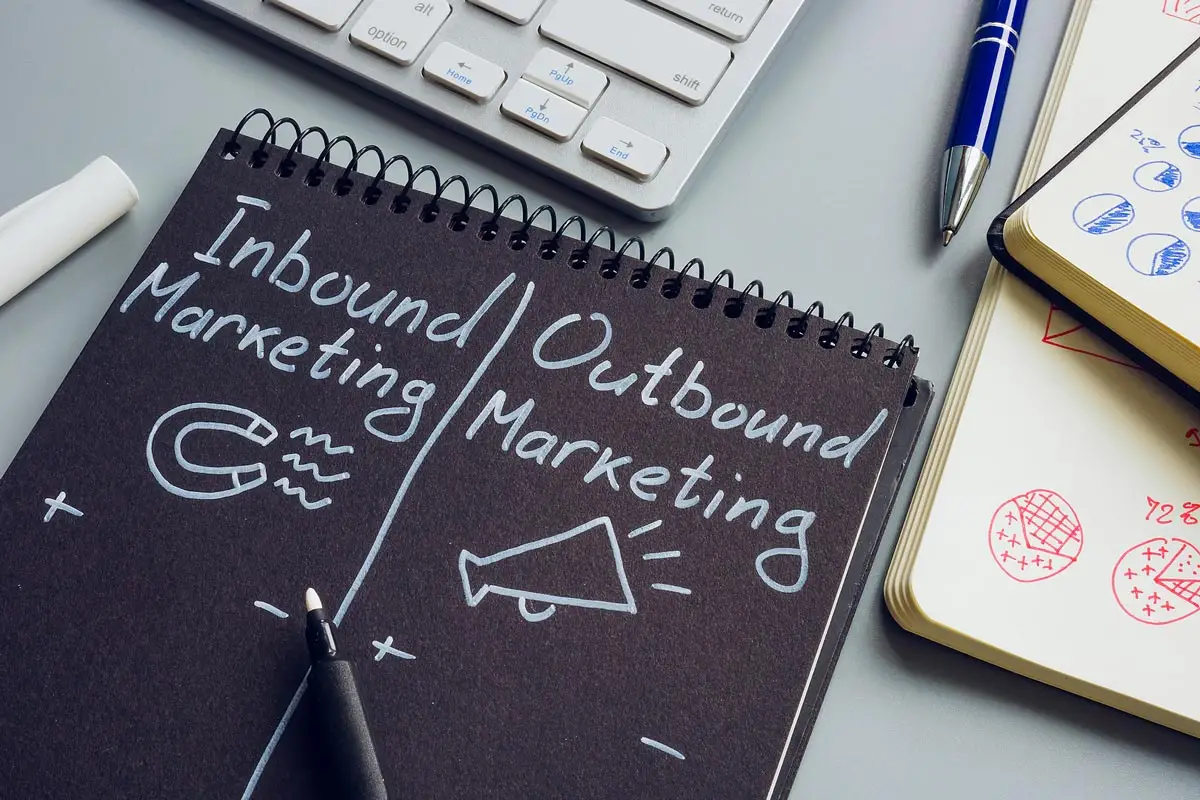Inbound Vs Outbound Marketing
As you build your business marketing strategy have you wondered about the difference between inbound and outbound marketing? Curious about which one is better for your company? Confused when one “expert” claims outbound is the only way and others say it’s a waste of resources?
What’s the answer and what method is the key to your business’ growth?
Here we’ll discuss the differences between inbound and outbound marketing so you can get a better picture of how they fit in your growth strategy.
As we see it, both are important and paired together, can fill the gaps in your marketing and sales process.
It really comes down to your business - industry, audience, and goals.
Let's explore.

Outbound marketing is a direct method of reaching out for new customers. The goal is to get your message out to as many people as possible in order to grab the attention of your next client.
Outbound marketing encompasses all traditional forms of marketing like billboards, tv commercials, and print advertising. Think salespeople working trade show tables, making cold calls, or passing out informational pamphlets. The ideology is that among the masses a few will need your specific product or service at that time and will respond to become your next customer.

Outbound is all about creating an interruption as people are going about their day so they think of your business. In the context of digital, outbound includes display ads online, sales emails, and pop up ads at the beginning of a YouTube video.
Outbound marketing is like a megaphone, trying to gain attention by pushing your message out to the masses with a loud voice. Most messaging is generalized because your audience is vast and language is disruptive because it’s competing with so many others. In simple terms, outbound casts a wide net to gain a few customers.
Inbound marketing is a value-based, indirect method that focuses on attracting customers to your business by publishing engaging and relevant content they’re already looking for.
Inbound targets specific markets more appropriately fitting the type of customer who will buy your product or service.
Utilizing digital marketing filtering tools and keywords you can selectively market to those actively looking for your product or service. Now you’re intentional and focused while guiding your potential customer through the buyer journey, from brand discovery to brand loyalty. After all, people find 80% of information about your brand and product online before they ever reach out to you.
Inbound marketing works like a magnet, publishing engaging and relevant content for potential customers who are interested in your services. Instead of marketing to everybody, using the inbound marketing approach selectively markets to only those who fit your target audience. This can save resources and make your marketing efforts more effective.
Your website, online content, social media presence, ppc and blogs all play a part of your inbound marketing plan. Additionally, through a strong SEO strategy everything you post online can attract traffic to your business, generate leads, and increase conversions.
Supporters for outbound marketing will argue that it is a stronger approach because it is a direct approach in ‘going after customers’. Instead of waiting for customers to walk into your business (or visit your website) you are “hitting the streets” and soliciting new customers actively. As a business, this is commendable. You can’t always wait for people to stumble across your company.
Outbound marketing also spreads your message to a large number of people giving your business greater exposure and visibility. The more people that see it, the more people will know about your business when they need it, now or down the road.

Proponents for inbound marketing will point out that the return on investment for outbound can be extremely low. You may be actively marketing but how many of those who hear or see your message are actually in the market for what you are offering? Wouldn’t your money and efforts better serve you if you knew where the highest concentration of those who needed you were and then you could market there?
That’s a huge part of what inbound does. Instead of hoping at least a handful of those within earshot of your message are the potential customers you’re looking for, inbound marketing sets up shop in the digital neighborhoods where seeing your message will be most relevant.
Cold calling is a part of outbound marketing, trying to generate leads where no connection has existed previously. When a lead comes through inbound marketing, it is already a “warm lead” or someone who you know is interested in what you’re selling. Warm leads always generate higher conversions, and more sales.
So, which is better? I’m not here to say one is, but to point out the differences and highlight how they can work together to support a robust and more complete marketing plan.
There are definite benefits to both methodologies.
Your specific industry and target market will influence the appropriate combination of the two.
Inbound and outbound marketing can work together and play with each other to establish a stronger and more complete overall marketing strategy.
In the digital landscape outbound marketing tools include display ads, social media ads, commercials on video platforms, and the like.
These ads will show up for anyone and everyone regardless of demographics or online information known about the users. They are broad reaching and help with brand awareness and recognition. Ideally they turn into lead generators.
Email marketing can also fall into outbound marketing as many email campaigns are sales-based advertisements looking to create leads and gain new customers. Emails are the modern-day cold call where you send your message directly to your potential customer and give them an opportunity to buy in with a call to action and link back to your website.
Inbound marketing utilizes social media (intentionally selecting the channels that are most relevant to your target audience), retargeting, landing pages, email marketing, PPC and SEO.
Your social media presence creates an authentic view of who you are as a company and a space where your customers (current and potential) can connect with you and build a relationship. 45% of people research new brands on social media which emphasizes the importance of keeping an up-to-date and true portrait of your company on your social accounts.
Social media also makes interacting with your audience a breeze. Through building rapport with those interested in your business, you are establishing yourself as the “go-to” company when they are ready to buy your product or service.

An attractive website with helpful and relevant content continues to build trust by keeping your messaging consistent and offering value.
You can set up specific landing pages that offer answers to commonly asked questions within your industry or other helpful information in exchange for collecting your reader’s information and the permission to contact them in the future.
Customer information can be used in automated email campaigns that keep your business top of mind, continue to offer valuable content, and provide further opportunity to engage with you - make a purchase, contact you, etc.
Those that have visited your website can be retargeted to. Instead of generic display ads that are shown to anyone online, retargeting ads are only shown to those who have previously shown interest in your company by going to your website. It generally takes up to seven “touches” before someone is ready to make a purchase with a new company. Having ads show up while they are browsing the web or on social media will remind them to return to your site and make a purchase, schedule an appointment, etc.
With PPC ads, you can set parameters and negative keywords so that your ads are only showing to the most appropriate audience. You don’t want to waste money (and time) running ad campaigns for a bogus audience. By being specific in your campaigns, you can show up first on the search engine results page when someone is searching for your product or service.

All inbound marketing efforts are compounded when paired with a healthy SEO strategy. From content on your website to the PPC parameters we just talked about, if you incorporate good SEO, the magnet of your inbound efforts will have a much stronger pull in attracting the customers you are looking for.
Want to learn more about the importance of SEO? Click here.
From the active and more aggressive outbound approach to the unintrusive inbound marketing tactics, make sure you’re being intentional with your digital marketing strategy. Without a plan your marketing will be weak and ineffective. Your desired customers will never find you and may be wooed by your competition.
Have questions or unsure or how to start?






